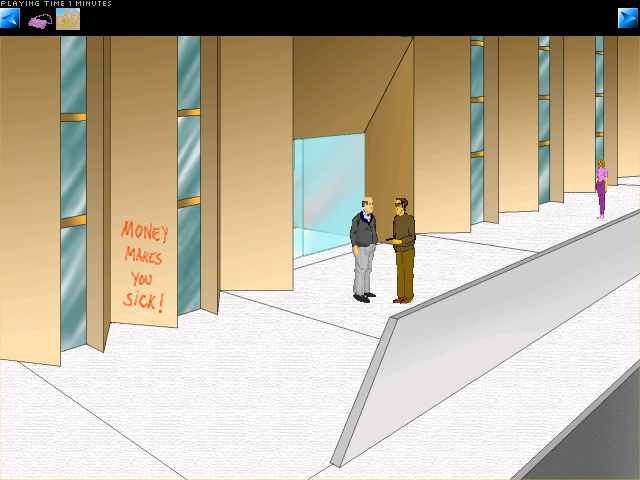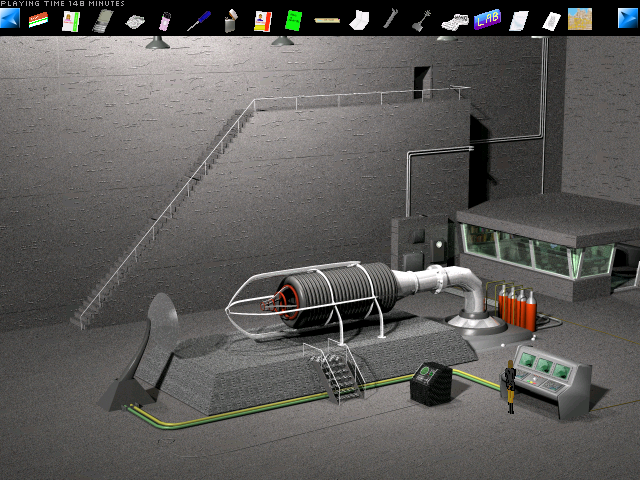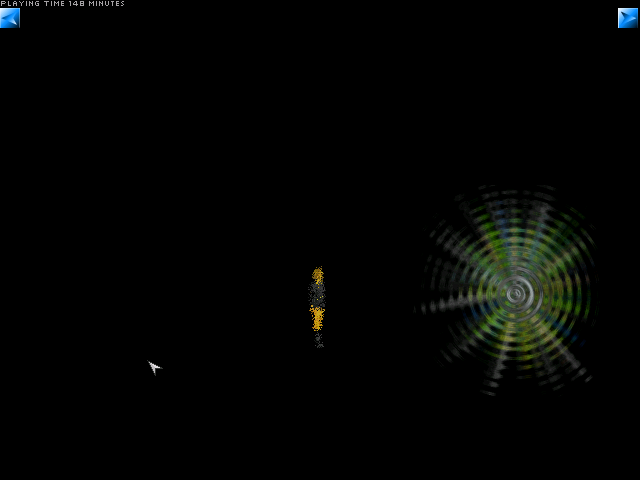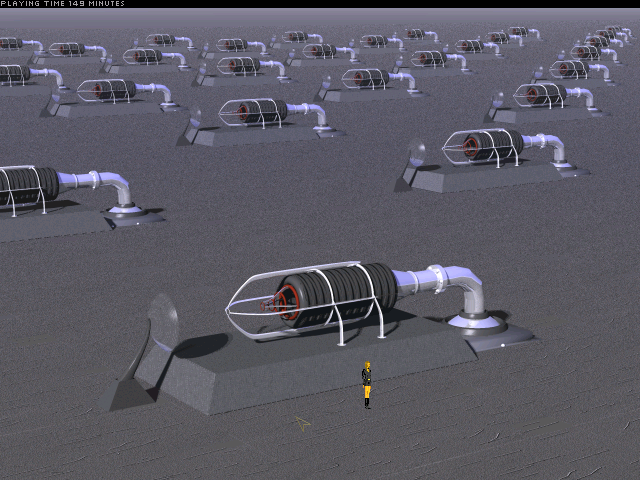Schrödinger’s law: the painful uncertainty of a work of fiction necessitating comparisons to our beloved cat in quantum superposition, until finally observing if it was useless or not. Usually when Schrödinger’s cat is brought up, and its application in The Uncertainty Machine is no exception, the potential superposition, the life or death instability that the cat theoretically exists in, is mostly glossed over. The cat is dead in a box, or the cat isn’t, but you can’t know until you observe—now that’s not really physics is it? Of course, everything is a matter of physics, but our reliance on observation is science, it is philosophy, it is existence itself. The crux is always opening the box and finding a cat, but without an unstable superposition it’s just a cat in a box.
Ever muddled, whiffing references, hinting at things without fully understanding their consequence: this is essentially why I found The Uncertainty Machine so appealing. It’s a big bite out of sociology and ideology, like any dystopian fiction, but without drowning in ennui or morality judgements, simply by neglecting to ground the actors or the setting enough to pull off a morality play. In what is one of the most unnecessary intro text scrolls, it’s established that in some western country, people are separated into two castes to guarantee at least some amount of the population lives comfortably. There’s no explained reason for this scarcity. No clarified difference between the castes. It just is; there’s sanctioned, approved citizens, and then there’s people and places deemed ‘off-limits’. I like that any possibly subtle application of this model-as-metaphor is just blown out with a glib statement that things are only slightly different from the present.
Harsh noise plays as the first scene appears, as an off-limits tries to mug an affluent looking man. I would commend this sound choice but never again does a similar kind of music take center stage. Mostly vaguely impressionist piano pieces play for the rest of the game. Wormy, repetitive pieces, an eeriness that accompanies the actor’s poisonous privilege. Sometimes the piano is highly compressed, cracking from a high bitrate. Only occasionally did the distortion seem intentional. The art is outside standard color theory, with gaudy and loud line art, but over the precipice of art I’d consider crude. Backgrounds are composites of straight lines, seeped in pale colors sucked of contrast, instilling an exact, sterile, and decrepit air to life in the city. Most everything is large, looming, presented in slanting angles, implying a hidden history, drawing attention inwardly. These present spaces as intimate and private, dissonant with their usual lifelessness. Inexplicably, there are 3D models, and pasted photographs, randomly existing in these spaces, adjacent to drawn objects. I’d say these additions highlight the artificiality of their environments, but having both formats feels arbitrary, messy. I’m not sure why they’re there.

I’m not sure why the game starts with loud noise either. There are appropriately dramatic confrontations later in the scenario, but nothing as intense marks them. To resolve the confrontation, the player, as Susan Gant, must first open her purse. This is literally the only time her purse is ever opened and there is no visible purse or pockets on her sprite. It opens anyway and various junk spills out. As a videogame protagonist, time doesn’t move, so the harsh noise loops while each item is examined, to determine which ordinary item will diffuse the situation, drilling in the slow banality of point and click mechanics. Since, for some reason, never brought up or clarified later in the story, her calls to her office won’t go through, she bluffs as if it did work, and the mugger runs away.
Most puzzles aren’t so dramatic or interpersonal. I don’t really enjoy typical adventure games for this reason. Contrived situations, like needing to repair an elevator by yourself, or breaking a window to distract police long enough to take evidence already forwarded to you, crop up in the first half of the game. Setpiece puzzles like these feel contained by their chosen format. They’re too afraid to break a rule of naturalism, a feeling that these things could happen, but are still in the gameplay uncanny valley. None of these things would happen. I know suspension of belief and all that, but, I prefer convoluted set ups, nearly impossible ones, like Nine Persons, Nine Hours, Nine Doors or 1953 – KGB Unleashed. Puzzles are inherently ridiculous and contrived; a real naturalism would lean into their conspiratorial nature. (Also I’m extremely, awfully, terribly bad at them.)
Thankfully, The Uncertainty Machine is not, initially, dense in puzzles (and though I want to be smug, its later puzzles are fantastic). Susan is a journalist tasked to write about a crime her boss caught wind of that hasn’t got a press release from the police, for some reason. Her work is investigative—illegally, but persuasively, and done regardless. A bulk of interactions in the first half are traveling and conversing with people related to the case. Detective work naturally makes the interpersonal into a puzzle. Dialogue is stilted and error-prone. People speak politely, formally, oddly, like they feel conditioned, cultured with a wall of their language. I know it is just the author’s imperfect english.
My clincher: kitsch art like this is tragically relatable because during periods of my life I have desired, tried to fit into a larger social context. I got things half right but that is never enough. Maybe games like these don’t signal anything to people who are successful in sticking to norms, or at least believe in their power. That’s where a typical critic would find the writing flawed, plot undeveloped, the art style inconsistent, the music grating. On a comparative scale those are true observations. So what? Some videogames utterly, unironically, strive to hit a mark of cultured greatness, and are handicapped, unable to be attractive. The near miss is beautiful in context. Its struggle is my struggle, when I’m vulnerable and try to follow a rulebook written for people not like me, as I try to be understood by those prone to misunderstand me.
A more general argument, that I’m using because I’ll always use it, is that we’re bombarded by carefully made and marketed things. In post-industrial, late capitalist society, most anything is uniform in intended shape and structure. Flagrant flaws rarely occur; overtly uncomfortable expression isn’t profitable. This isn’t a new observation, but I’m suffocated daily by overdesigned necessities and marketed an infinite amount more. It’s not always comforting to retreat to overtly appealing, specifically focus tested, outwardly attractive, sycophantic art. Not everything, or everyone, has or needs to have general appeal. That pressure is ever instilled by adoring the conventional. Embrace videogames that make mistakes.
***
I want to continue with spoilers for the ending. If you feel like playing the game, please do and come back. It only takes about two hours (well, if you succumb to a walkthrough…) I found its aesthetic precious and individual; the game is worth playing for that alone. Various plot beats and reveals are timed for great effect, so if you prefer that kind of thing it’s best to be unspoiled. With a strong ending, it is The Uncertainty Machine’s full range of expression that so impresses me, not just its chafing spots, and well, spoilers ahead.
Susan discovers that a recent newsworthy death was a murder, covered up by the police. A murder that was inextricably linked to the break-in she was investigating. Art Mathus, a reclusive physicist, got a tip that he was soon to be assassinated and entrusted a sculpture to a clueless friend of his. This sculpture was the target of burglary Susan was initially investigating. She doesn’t recover it, but manages to get a photo. On it was an inscription in an unused language. Decoded and rearranged to make a poem, this new arrangement is the correct pressing order for buttons found on a painting in Susan’s office. Inside is a glass lense.
To understand what Art died for, Susan tracked down his research partner Jacob Illya. She finds him at the bottom of a secret passage in a nondescript warehouse. There’s a stand-off. Both are deathly aware the other could be a plant, that they’ve gone too far and their time is up. A roundabout conversation occurs, in the background of a huge, alien, cylindrical machine. Jacob has contacts at Susan’s place of employment. As their fears betray each other, and with Susan’s mobile phone, it’s simple to establish the authenticity of their meeting.

The caged machine is the titular uncertainty machine. Art and Jacob were studying point particles, preons, sub-quarks, and their relation to potentiality. Popular models of particle physics deny the existence of sub-quarks. Knowing the potential results of their experiments, the two conducted their research in secret, avoiding any loss of reputation or possible government intervention. According to Jacob, they succeeded in creating a machine that could manipulate the state of particles themselves. The circumstance and timing of their existence could be altered. By drawing from edited particles, ones with potentially different rates of existing and decaying, they could generate infinite, clean, renewable energy. I get the feeling the science doesn’t quite check out as possible, but it gives the proceedings a mystical, conspiratorial air, similar to Steins;Gate. A possibility that what we’ve been told is truth is just something we’ve been told.
Conspiracy is at the heart of The Uncertainty Machine. Susan learns that the government suppresses and censors what her newspaper can publish. The police willfully obscure evidence and facts to manipulate the narrative of criminal activity. Preserving a utopia in scarcity is littered with janitorial expressions, predicated on a constant need to hide and clean anything that is undesirable. When structures are unable to make actionable change, they struggle to maintain the appearance of authority. Sustainability is desperately needed—but it needs to line someone’s pockets, it needs to cement someone’s legacy and power. That’s why Art Mathus was murdered. He wanted his revolution in the hands of everyone.
A last, absurdly difficult puzzle, hides the real lense needed to use the uncertainty machine, as The Uncertainty Machine goes full National Treasure. The lense Susan found after decoding the statue’s double meaning was a fake, made to be found easily by anyone looking for it. Art designed the carving to hold a double-double meaning. It seems the code to an obscure relationship of artwork related to him, but it’s real meaning is personal and deeper, being actually a reference to the writings of Nuno Grande. The referenced quotation was something about the self-evidence and actualization of truth, slogans held closely by the easily motivated and impressed. I didn’t much care for it. However, the molding of it into something conspiratorial was powerful. Descriptions of various objects kept in a historical museum (and I’ll confess I don’t know which ones because this puzzle was way too hard for me) contained keywords from the Grande quote. They directed to a secret compartment with the real lense kept inside, and each exhibit contributed to a numerical password. This intensely held belief of the author was made to be unassuming, duplicitous. Doublespeak crafted to signal to his allies and deceive those who would cheat and ruin humanity. Like the ugliness Susan had discovered in her utopia; hiding its true intents and machinations under the guise of easy placations. Secret machinations fought with more fantastical, impossible systems of secrets.
When Susan returns, Jacob is still out trying to divine Art’s cryptic messages on his own, so she tests the machine herself, by first placing the lense into the machine, then inputting numbers gleaned from museum exhibits as coordinates. It turns out Art lied—the machine doesn’t extract energy, it projects it. Susan utters her own surprise, but resolves to walk into the light anyway. Inside is pitch black, a perpetual void, graced by some bouncing, soft-edged, feedback and distortion. Glitch music for where matter and space are broken, directionless. At the far end is a light. It speaks, a resident god of its own realm (if you’ve played Xenogears it does resemble, well it literally is, a wave existence). They reveal themselves to be Art Mathus. Studying this dimension distorted his relationship to time; there exists the Art Mathus that left and died in Susan’s dimension and there exists the Art Mathus suspended and molded into a being of pure energy. Though he attempted to leave, it seems that he did and he didn’t simultaneously. There’s not much time to process and cope with this transhuman revelation. Art tells Susan that she should rely on Jacob and go public. It’s time for anyone to have the freedom to live in a world they choose. Susan isn’t confident that’s natural, or disregarding that, even good for mankind.

There comes a choice, a final choice to determine how the game ends. Some people take umbrage at such choices, lamenting that a game should’ve allowed choice the entire time, and not shown weakness at the final moments of narrative. I don’t see end choices like this. I’ll quote Max though (yes from this very same damn site):
“Having an ending wrapped in a choice with broad, plot-wide implications like this isn’t unique, dozens of games utilize this trope. It allows a respite of player agency, but it’s so little and so late. I don’t think that’s the point of it. It’s brutish and neat in how it completely retextures the story. One simple choice redefines all of the previous acts, actions, and interactions. To comply with new development of our character, every detail takes on new meaning, and different motivations manifest.”
Essentially the choice is not how the game ends, but deciding how the game was progressing up to this point. Susan can leave the facility and take the lense with her, never illuminating Jacob to what she discovered. This reflects how she understands her privilege. It was her position as a journalist to begin with that gave her the connections and ability to be privy to the information she gained up to this point. She essentially relinquishes control to organizations she knows are corrupt, meaning this whole time she was only doing her job, doing whatever would advance her career. Once realizing it won’t help her career, the work is a bust. This retreat to comfortability is disguised as leaving humans to the order they’ve chosen for themselves, but is swiftly punished. Susan’s publication company is censored for their criticisms of current events. Her own position shut down by the government she placed her trust in.
Another choice is to input one of the coordinates laying around and travel on your own. It’s implied that Susan ends up becoming a being of pure energy in this dimension. This is also escapist, but means Susan was flighty and excited by the work she was doing. Pure hedonism; undeterred by conditionals that notably intersect with her being. She left because she could, though in no way did she sabotage Jacob on her way out either. I think that’s why the third ending—ostensibly the “good” ending—doesn’t really detail the consequence of interdimensional travel or tip its hand as being right option, a temptation many videogames succumb to. It shows a useless, mass amount of transportation machines, bleak and scornful. Susan remarks only the blunt obvious, things have changed, and hopes she did the right thing.

Oppression exists relative to how an individual reacts to it. The Uncertainty Machine scripts out a vague amount of corruption and injustice. In a way it feels like a general sensibility of power dynamics. They’re empty of details, so they can be filled with anything. Though, definitely, what’s displayed is a gross misuse of power. When collective organizations are not collectivist, when they are for their own bubble, then they’re contrary to humanity. The Uncertainty Machine posits three reactions to uncovering this knowledge:
- Selfish people are people too. The world became like this naturally, it is the will of people to come to this point, and it will sort itself out. Implicitly, oppression is impossible. This is easy to rationalize when in a position of privilege.
- Oppression can be acknowledged as wrong and be fundamentally opposed, even if the ways and circumstances available to push against those structures feel at odds with personal interest. It’s possible to pursue personal fulfillment while side-stepping toxic behaviours, while still in slight ways enabling others to work out a more sustainable future.
- Status quo is not a rule of gold. If current order is not sustainable, strive to making a sustainable world. Roles that seem small can tumble into a lasting and crucial impact for achieving goals of new sustainability, but it takes actionable effort, and activism often closes more comfortable positions.
The second ending, represented by becoming wave existence, is an empathetically lonely one. Rising to new personal potential may contradict necessary responsibilities. There’s clearly a wrong choice, but none of these are right choices. These are hard choices.
***
Lastly I want to talk about an author insert. No, not the delicate kind. Graffiti on the warehouse, the story-relevant warehouse, containing the principle dilemma of physics and philosophy, reads an all frontal glib, “email the author!” When clicked on it expands further: “Don’t forget to drop an email to ratracer@sapo.pt about your opinions of the game. Thank you – signed Eduardo Campos, alias ratracer.”
From that message, I see upfront, shining honesty in wanting to have a conversation. Before social media, before game press gave a shit about videogames not directly marketed to them, it was just these ragtag communities of people who wanted or needed to create. I hope ratracer was satisfied by the middling, hobbyist focused reviews received on the Adventure Game Studio website. It was 2003 so there wasn’t much else to aspire to. Since this is ratracer’s one and only game, they likely were satisfied with their achievement. I hope so anyway. The Uncertainty Machine is a hell of a game, unique and affecting. In stylistic, or critical terms, it’s a distilled, focused argument for why later puzzle-adventure games like the Virtue’s Last Reward series are so cohesive and convincing in their marriage of scientific and mechanical conspiracies. As a freely released game, made with accessible dev tools, it did not get to rest anywhere near videogame canon, and I absolutely think the game deserved better.
Ever the lie marches on, that if you make a good videogame, people will want to play it. Who played this one? Good means conventional and conservative in aesthetic, marketing, and distribution. Good means connections and power. I don’t give a fuck about good videogames. I write for anyone like ratracer who made their personal videogame and just wanted to be heard.

Oh wow! Feels good to read such a review about my game. Thank you! I was wanting to go on and more deeply onto a new game, which I did for a while, but had to stop when it was still in a early stage.
Please feel free to get by through my (functional) email…
P.S. My email address published in the graffiti went useless only a few months after releasing the game, so I lost track of any feedback from then on.
P.S. 2. My comment, relating to the game I made – The Uncertainty Machine – was somehow sent to a different game. I don’t know why!
LikeLiked by 1 person
oh hey there! no exaggeration, the uncertainty machine is one of my favorite games now. if you are done making games that is fine, though I would be really excited to play a new game that you make. I would shoot you an email but I have no idea what I would talk about, haha…
it’s good to hear from you though, I hope you’re doing well
LikeLike
Once again, thanks a lot.
Well, I think my game making days are truly over. I would like to think that they’re not as I had some of the best nights of my life making TUM…
Anyway… When I was near the end of making TUM, I went on studying 3d modelling as I was told that it was way faster to draw backgrounds and sprites (I learned that when you’re slow, you’re slow, anyway) – that’s why some sets in TUM were modeled with 3d tools. As it turned out, as I was developing the new game I got better and better at 3d modelling and went on to a reasonable semi-pro career of 3d modeller and didn’t have any more time or stamina to dedicate to game making…
LikeLiked by 1 person